Master your outdoor cooking with these proven heat focus techniques. You'll achieve better results by establishing multiple heat zones, using strategic coal placement, and implementing dual heat source control. Direct your heat precisely with single-point positioning and reflective materials to maximize temperature distribution. You can eliminate hot spots through cross-pattern applications and rotation methods, while layered fire zones offer versatile cooking options. Cross-grid temperature control guarantees even cooking, and proper hot spot management prevents burning. Understanding these professional-grade approaches will transform your basic grilling into exceptional outdoor cuisine. Let's explore how to put these techniques into practice.
Zone Heat Management
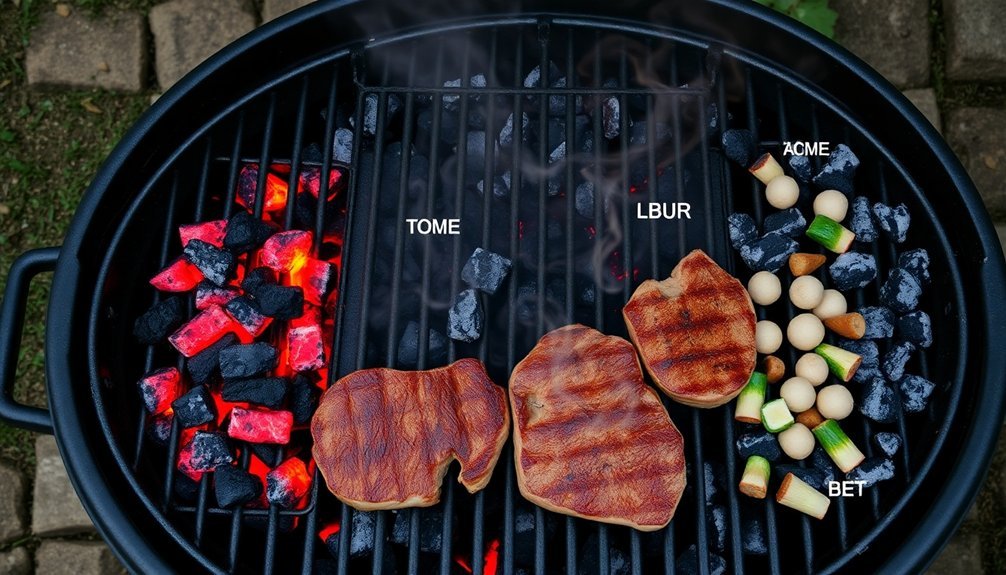
Every successful outdoor cooking session relies on mastering zone heat management.
You'll need to create distinct cooking areas by establishing a hot zone with 12-15 lit charcoal briquettes on one side and a cool zone on the opposite side for indirect cooking.
Set up your zones by using a chimney starter to light the charcoal, then bank it to one side. This allows for proper heat zone separation and more controlled cooking temperatures.
Control the temperature by adjusting both top and bottom vents – opening them increases heat while closing them reduces it.
For more versatility, try a three-zone setup with high heat in the back, medium heat on the side, and a cooler center zone.
You'll want to maintain temperatures around 350-375°F in the hot zone and 225-300°F in the cool zone for best results.
Single-Point Heat Direction
Building on zone heat mastery, single-point heat direction offers a focused approach to outdoor cooking. You'll need to position your charcoal strategically to create a concentrated heat source for precise temperature control. Using a charcoal chimney to pre-heat your coals guarantees even distribution when you're ready to place them. This setup creates a heat gradient effect similar to two-zone grilling techniques.
| Tool | Purpose | Best For |
|---|---|---|
| Charcoal Chimney | Even Coal Heating | Quick Start |
| Lump Charcoal | High Heat Output | Searing |
| Briquettes | Temperature Stability | Long Cooks |
Consider your environment when directing heat. You'll want to shield your grill from wind to maintain consistent temperatures. In colder weather, you might need extra charcoal or adjusted airflow settings. Control the heat intensity by raising or lowering your charcoal tray, and remember that proper airflow management through dampers is essential for maintaining your target temperature.
Dual Heat Source Control
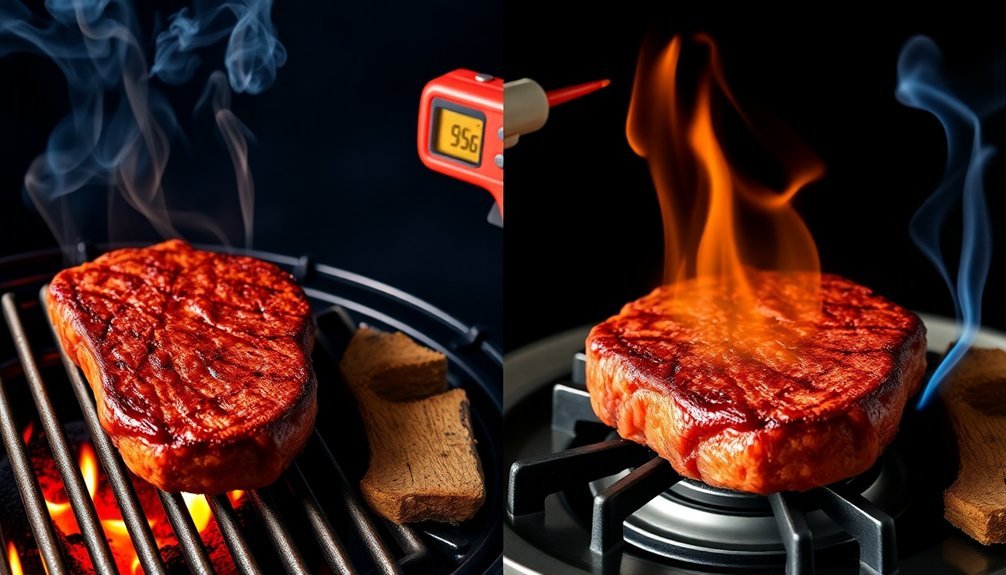
When mastering outdoor cooking, dual heat source control elevates your culinary possibilities by combining different fuel types for ideal results.
You'll have the flexibility to switch between natural gas and propane, optimizing your cooking based on outdoor conditions and fuel costs. The burner system delivers a powerful 32,000 total BTUs for maximum cooking performance.
For the best dual-heat cooking experience:
- Set up your LED-illuminated control knobs to monitor both 16,000 BTU burners separately
- Use the spark ignition system to fire up each heat source quickly and reliably
- Take advantage of the double-lined hood for superior heat retention when using both fuel sources
- Monitor outdoor temperatures to adjust your cooking strategy accordingly
Your professional-grade equipment integrates seamlessly with other outdoor kitchen elements, while the stainless steel cover protects your dual fuel system when it's not in use.
Heat Reflection Positioning
Beyond dual heat sources, proper heat reflection positioning can dramatically boost your outdoor cooking efficiency.
You'll want to place reflective materials strategically around your cooking area to maximize heat distribution. Consider using fire glass or steel components to direct heat where you need it most, and position your cooking station away from wind drafts that can disrupt heat flow. A portable fire reflector can enhance warmth retention while cooking in cold conditions.
For ideal results, set up your cooking area in a sheltered, central location and incorporate reflective surfaces at multiple angles.
You can use aluminum pans as makeshift reflectors or install professional-grade reflective materials like Reflectix. If you're using a fire pit, choose its shape based on your needs – round for even heat distribution or rectangular for focused heating.
Remember to leave enough space for adjusting your position as wind conditions change.
Strategic Coal Placement
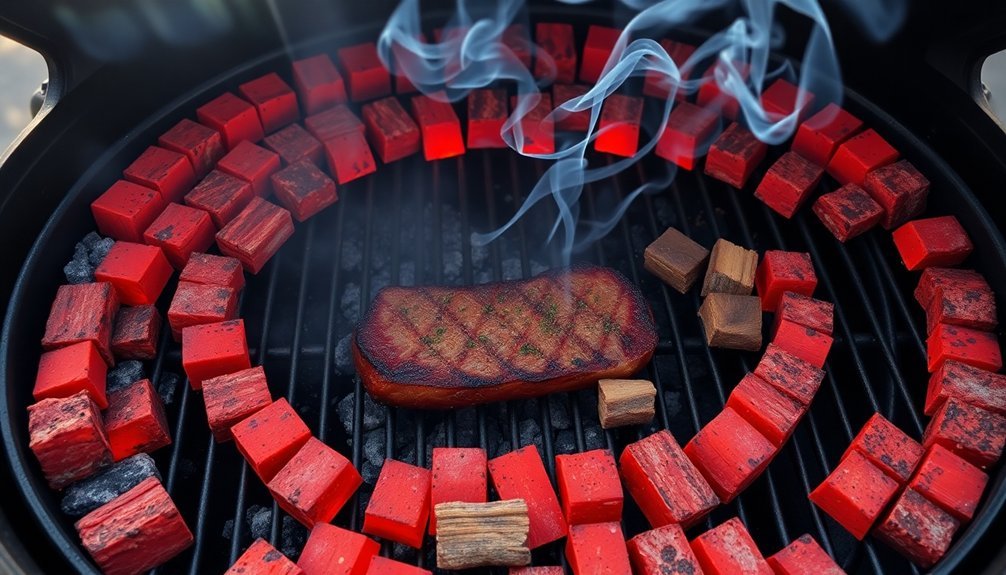
Mastering strategic coal placement transforms basic outdoor grilling into precise cooking control.
You'll discover that different arrangements serve specific cooking needs, from quick-searing burgers to slow-roasting whole birds.
- Direct heat setup spreads coals evenly across the grate, perfect for searing and cooking foods requiring consistent temperatures.
- Two-zone arrangement piles coals on one side, creating both hot and cool zones for versatile cooking options.
- Complex arrangements like portrait frame or front-and-back setups offer specialized heat distribution for specific dishes.
- For best results, you'll want to use a chimney starter and quality hardwoods like oak or hickory.
Remember to monitor and adjust your coals throughout cooking, especially when fat drips cause flare-ups.
You'll need to stir hot coals occasionally with a long-handled tool to maintain even heat distribution.
Temperature Mapping Your Cooking Area
How well do you really know your grill's temperature zones? Understanding your cooking area's heat distribution is essential for perfect results. You'll find several effective methods to map your grill's temperature patterns.
| Method | Equipment Needed | Best For |
|---|---|---|
| Bread Test | White bread slices | Quick visual mapping |
| Digital Monitoring | Wireless thermometer | Precise temperature control |
| Data Logging | Temperature sensors | Professional-grade mapping |
| Manual Testing | Infrared thermometer | Spot checking |
The bread method offers a simple way to visualize hot spots – just arrange slices across your grill and watch how they brown. For more precise measurements, you'll want to use a dual-probe wireless thermometer with Bluetooth connectivity. Once you've mapped your grill's temperature zones, you can strategically place foods to achieve the perfect sear or slow cook.
Concentrated Solar Cooking Methods
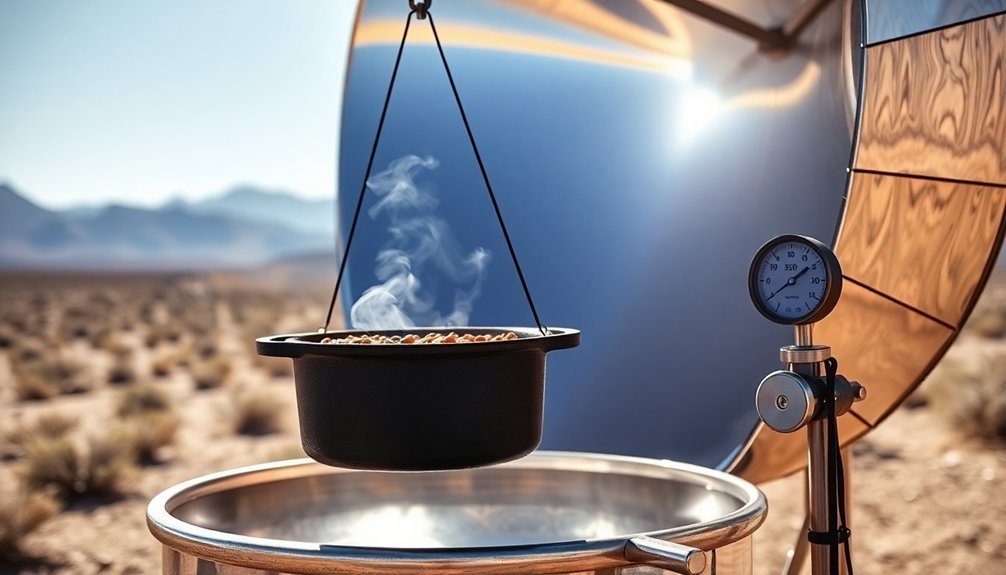
Sunlight transforms into intense cooking power through concentrated solar cooking methods. You'll find parabolic reflectors and vacuum tubes converting ordinary sunlight into temperatures exceeding 250°C, perfect for frying and boiling water in under 10 minutes.
- Position your cooking pot at the parabola's focal point where reflected sunlight converges.
- Track the sun's movement using castor wheels or automatic mechanisms.
- Choose between different sizes (SK-10, SK-14, SK-23) based on your group's needs.
- Monitor your cooking closely to prevent food from burning.
For maximum efficiency, you'll want reflective surfaces with 90% or higher reflectivity, like anodized aluminum or mirrors.
Vacuum tube systems offer an alternative, using evacuated glass tubes as super-efficient insulators. These borosilicate tubes, lined with metals like copper, can achieve over 90% solar energy efficiency.
Multi-Level Heat Distribution
When cooking outdoors, multi-level heat distribution revolutionizes your grilling game by creating distinct temperature zones for simultaneous cooking. You'll master temperature control using ceramic deflectors and adjustable grids, allowing you to sear steaks while slow-cooking ribs to perfection.
| Heat Zone | Best Uses |
|---|---|
| High Direct | Searing steaks, burgers |
| Medium Direct | Chicken, vegetables |
| Low Direct | Fish, delicate items |
| Indirect Hot | Roasts, thick cuts |
| Indirect Low | Smoking, ribs |
Modern grills like Kamado Joe and Saffire feature split grids and multi-level cooking systems that'll expand your cooking possibilities. You can easily arrange half-grids to create personalized heat zones while maintaining temperature control. With UL Safety Certified equipment and durable construction, you'll achieve consistent results across various cooking methods.
Direct Heat Focusing Techniques
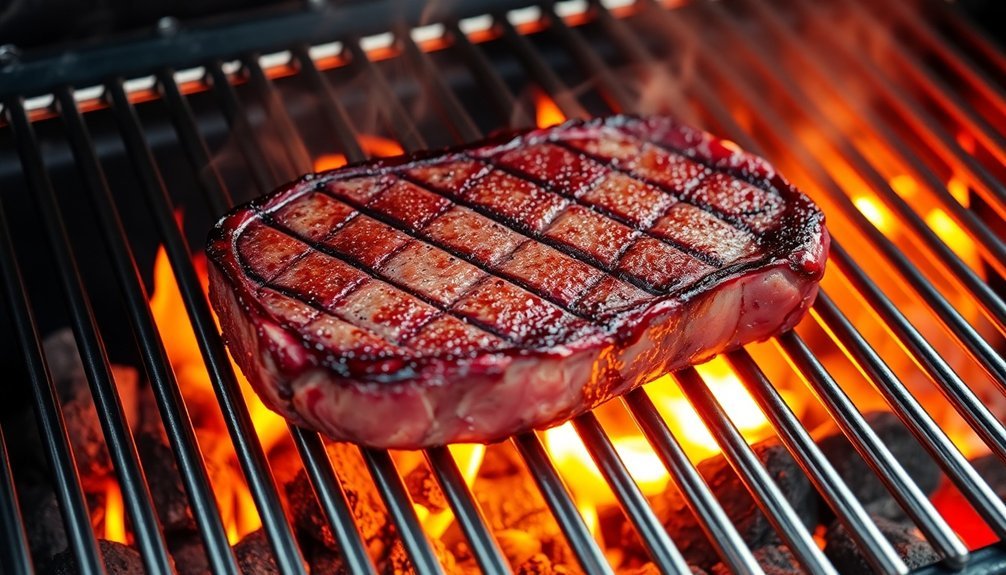
Direct heat mastery forms the backbone of outdoor grilling success.
You'll need to preheat your grill properly and maintain temperatures between 400°F and 700°F for ideal results. For the best direct heat cooking experience, keep your grates clean and well-oiled to prevent sticking while achieving those coveted grill marks.
Follow these key steps for perfect direct heat grilling:
- Position thinner cuts like burgers and chicken breasts directly over the heat source
- Watch cooking times closely – they'll be shorter than you might expect
- Monitor for caramelization on the food's surface without burning
- Keep moving items around to prevent hot spots from overcooking certain areas
Cross-Pattern Heat Application
When setting up your outdoor cooking space, you'll want to establish layered fire zones that mirror professional griddle systems with their edge-to-edge temperature control.
You can manage hot spot rotation by regularly adjusting your heat sources in a cross-pattern configuration, similar to how commercial griddles maintain consistent temperatures across different zones.
Cross-grid temperature distribution lets you cook multiple items simultaneously while maintaining precise heat control, just as professional ventless griddles achieve with their independent inner and outer heating zones.
Layered Fire Zone Setup
As outdoor cooking enthusiasts seek more control over their grilling temperatures, the layered fire zone setup offers a sophisticated cross-pattern approach to heat management.
You'll find this versatile technique allows you to cook multiple dishes simultaneously while maintaining precise temperature control.
- Start with a two-zone setup for basic temperature management, placing charcoal on one side for searing and leaving the other bare for slow cooking.
- Advance to a three-zone configuration by creating a slope of coals from high to low, giving you high, medium, and indirect heat areas.
- Master the three-zone split fire by placing coal piles on opposite sides for even heat distribution.
- Experiment with ring of fire or bull's-eye patterns for specialized cooking needs, using the perimeter or center for direct heat while maintaining indirect zones.
Hot Spot Rotation Methods
Building upon your mastery of fire zones, understanding hot spot rotation takes your grilling precision to the next level. You'll need to identify hot spots caused by uneven heat distribution, often resulting from clogged burners or worn flavorizer bars. To combat these variations, implement the clockwise rotation method and use quality grill grates.
| Action | Purpose |
|---|---|
| Grid Pattern Setup | Create organized spacing with one vacant spot |
| 60-Second Rotation | Move meat clockwise into empty space |
| Single Flip Timing | Combine with rotation to prevent burning |
| Cross-Pattern Grates | Guarantee consistent heat distribution |
You'll want to maintain your grill regularly by cleaning burner tubes and checking for corrosion. This proactive approach, combined with the rotation technique, helps achieve evenly cooked meat every time you grill.
Cross-Grid Temperature Distribution
Through innovative cross-pattern design, modern grills have revolutionized heat distribution for more consistent cooking results. This technology guarantees even heating across your cooking surface while creating those appealing sear marks you'll love on your grilled dishes.
You'll find these advanced cross-grid systems particularly effective because they:
- Eliminate hot and cold spots that typically plague traditional BBQs
- Transfer heat more efficiently through radiation and convection
- Allow independent temperature control across different cooking zones
- Reduce flare-ups through protected infrared burners
The cross-grid design doesn't just improve performance – it's transforming how you'll cook outdoors.
With faster cooking times and self-cleaning features in many models, you're getting professional-grade results while spending less time on maintenance.
Whether you're grilling, smoking, or making pizza, this technology guarantees your food cooks evenly and retains more moisture.
Frequently Asked Questions
How Do Weather Conditions Affect Heat Zone Management During Heavy Winds?
You'll notice heavy winds disrupt your grill's heat zones by causing uneven heating and temperature fluctuations. You need to adjust vents, monitor temps closely, and shield your grill to maintain consistent cooking zones.
Can Aluminum Foil Effectively Redirect Heat in Outdoor Cooking Setups?
Yes, you'll find aluminum foil effectively redirects heat in outdoor cooking. You can use it to create wind barriers and reflect heat back to your food, improving cooking efficiency and maintaining temperature control.
What Safety Precautions Are Needed When Using Multiple Heat Sources Simultaneously?
You'll need proper spacing between heat sources, constant monitoring of each unit, and clear traffic paths. Don't let vents overlap, wear heat-resistant gear, and keep fire extinguishers nearby for each cooking station.
How Does Altitude Impact Temperature Control and Cooking Times Outdoors?
You'll need longer cooking times at higher altitudes since water boils at lower temperatures. Plan to increase cooking time by 25-50% and add extra liquid to compensate for faster evaporation.
Which Woods Create the Most Consistent Heat for Extended Cooking Periods?
You'll get the most consistent heat from dense hardwoods like oak and hickory. They'll burn slowly and steadily, providing reliable temperatures for hours. Ash and maple are also excellent choices for extended cooking periods.
In Summary
You've now mastered key techniques to control and direct heat for ideal outdoor cooking. By applying these focused heating methods, you'll transform ordinary meals into perfectly cooked outdoor feasts. Whether you're using coal placement, solar methods, or multi-level distribution, you're equipped to handle any outdoor cooking challenge. Put these heat management skills to work, and you'll see the difference in every meal you prepare outdoors.

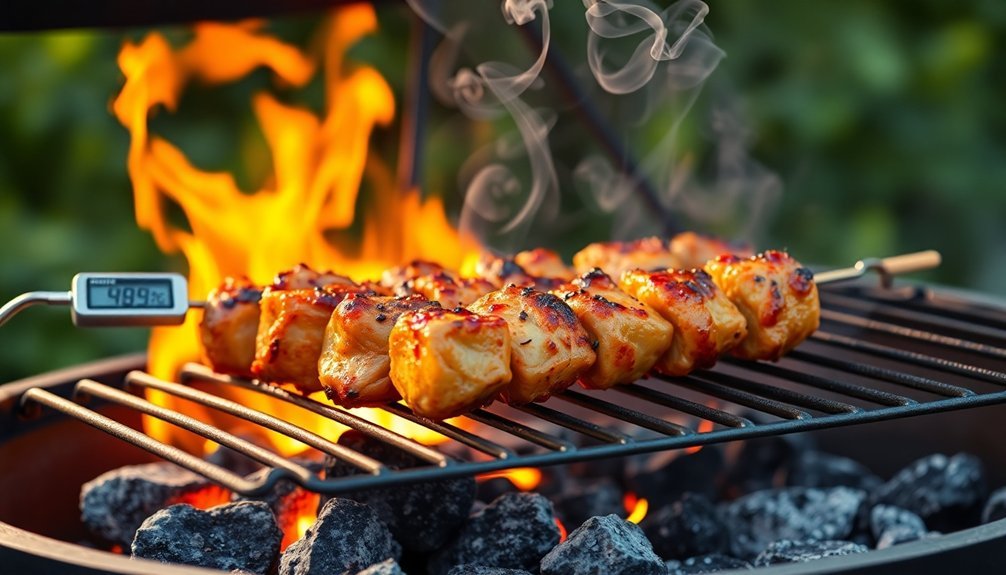
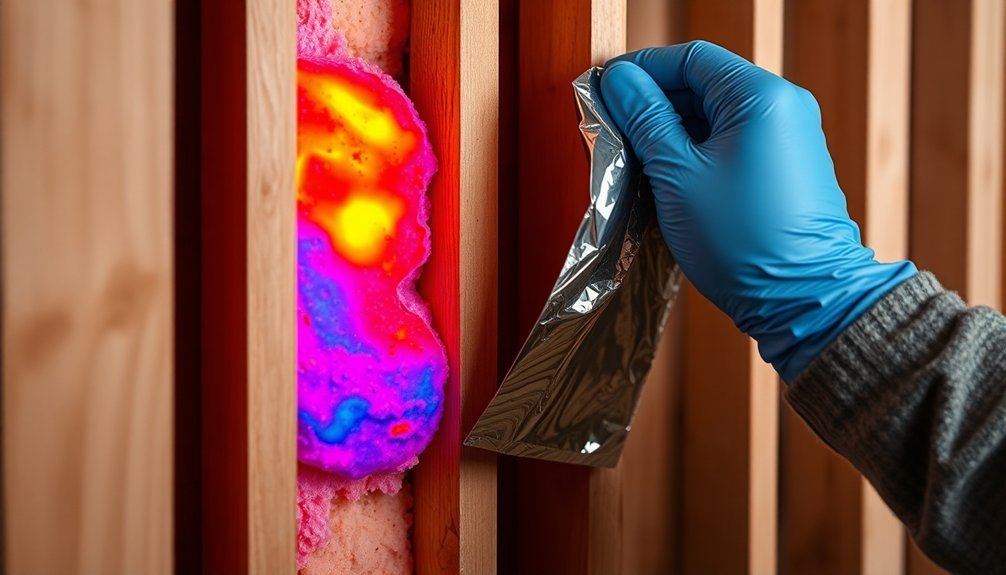
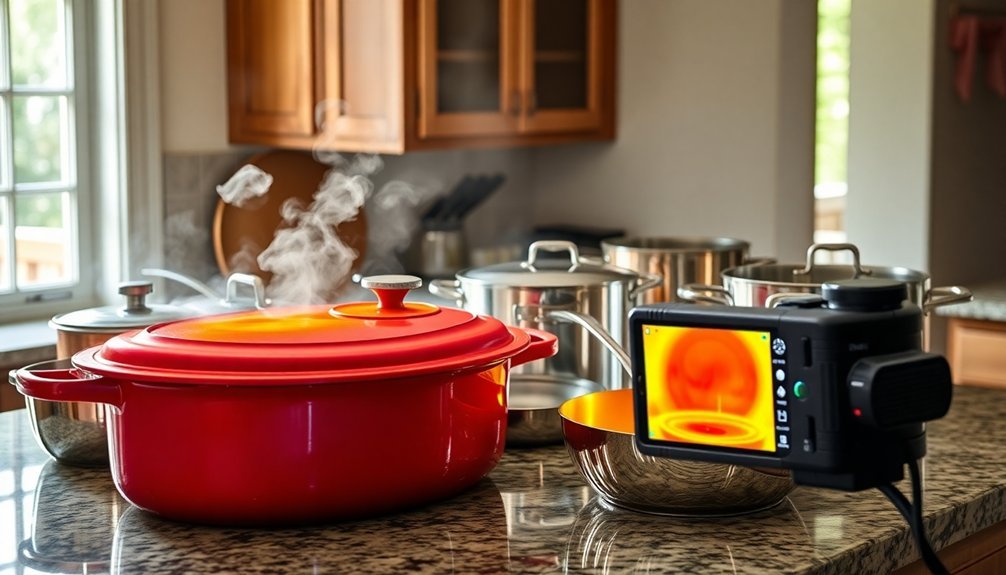
Leave a Reply